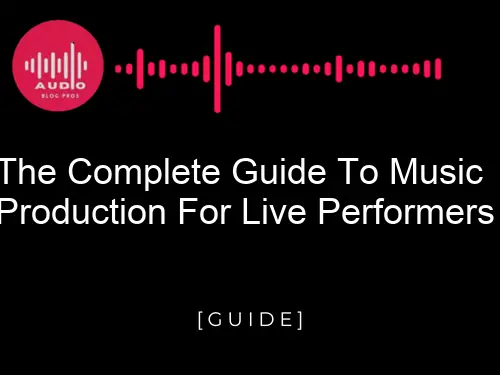Are you a live performer looking to take your show to the next level? Do you want to learn how to add music production live elements to your live performance but don’t know where to start? Then this post is for you! In this blog post, we’ll give you the ultimate guide on music production for live performers. We’ll cover everything from setting up your gear to using popular software and plugins. So if you want to learn the ins and outs of music production for live performances, then keep reading!
Table of Contents

Essential Gear for Live Music Production
Live music production can be a daunting task, but with the right gear and a bit of know-how, it can be a rewarding experience. Essential gear for live music production includes a digital audio workstation (DAW), mixer, audio interface, microphones, and speakers. In addition, it is important to have a good understanding of audio processing and recording techniques in order to create a unique sound for your live performances.
One of the most important aspects of live music production is ensuring quality performance. This can be difficult when faced with technical challenges during a performance, but by using the right equipment and strategies, you can overcome these obstacles. For example, using multi-track recording while playing live can help you capture better sound quality and improve your mix. Additionally, creative processing techniques can add depth and character to your soundscape.
By following these tips, you can create a successful live music production career.

Strategies for Overcoming Technical Challenges During Live Performances
There are a number of technical challenges that live performers face when producing music. Some of these challenges include dealing with latency, sound quality, and bandwidth limitations. To overcome these challenges, it is important to have a sound production setup that is capable of handling the various demands that are put on it. Additionally, it is important to be aware of the various techniques that can be used to improve sound quality and minimize latency.
One of the most important aspects of sound production is ensuring that the audio data is processed in a way that produces the desired results. This can be done through a variety of techniques, such as creative processing, multi-track recording, and efficient data management. By using these techniques, it is possible to produce high-quality audio without sacrificing performance or latency.
In order to ensure quality performance and mix during live performances, it is important to have appropriate monitoring equipment. This equipment should be able to handle the various demands that are put on it, including high levels of distortion and noise. Additionally, it is important to have a system in place that can quickly identify and resolve any issues that may arise.

The Benefits of Multi-Track Recording While Playing Live
The Benefits of Multi-Track Recording While Playing Live
Achieving a high level of live performance requires a lot of dedication and hard work, but it can also be gratifying. Recordings made during live performances can provide fans with a real insight into the artist’s creative process and candid nature, sharing an unbridled passion for music as well as showcasing spontaneity and energy that simply cannot be captured in studio recordings.
Multi-track recording provides artists with an enormous amount of flexibility when it comes to editing and mastering their recordings, allowing them to make sure each note is played perfectly and every musical idea expressed in its fullest potential. Additionally, multi-track recordings can often be used as stepping stones for creating fuller commercially released albums later on down the road.
Live performances are unique opportunities that should not be missed simply because they don’t allow for the same level of precision or control found in studio recordings; by capturing these moments in time, you will enrich your own artistic journey considerably while giving back to your fanbase in more ways than one.
Developing a Unique Sound Through Creative Processing Techniques
There are a few key techniques that can be used to produce a unique and powerful sound when playing live. One of the most important aspects of sound production is processing, which allows you to shape and manipulate the audio signals being sent through your equipment in order to achieve your desired outcome.
There are many different processors available that can be utilized for specific tasks, such as EQing and compression/limiting in order to control the dynamics and levels of your sounds or adding effects like reverb, delay, and chorus for more spacious or textured sounds. Experiment with various processors and find what works best for you as a performer.
Additionally, it’s important to keep an ear out for any potential sonic weaknesses or problems during live performances so that you can address them promptly. By taking thoughtful precautions along with employing creative processing tools, you can create powerful performances full of evident detail and dynamics.

Ensuring Quality Performance and Mix with Appropriate Monitoring Equipment
There are a few essential things you will need in order to produce high quality music live. One of the most important pieces of equipment is a solid audio interface. This will allow you to connect your instruments and monitors together, as well as handle all the data flow between them. It’s also important to have good-quality speakers, as they will be responsible for projecting your sounds onstage. If you’re working with any other electronic devices like synths or drum machines, make sure they are fitted with compatible outputs and inputs so that they can be connected properly.
Another key factor when producing live music is efficient workflow. By automating processes where possible, you’ll be able to take more focus on what matters – your performance! There are plenty of software options available that can help streamline common tasks such as recording and mixing, so it’s worth trying out a few of them if you’re starting out in this field. Finally, make sure to monitor your audio carefully during performances; mistakes can easily be overlooked if everything is happening in silence!

Maximizing Efficiency by Automating Processes During Live Production Sets
Understanding the Benefits of Automation
Live music production can be a very time-consuming and labor-intensive process, which can often lead to inefficient and low-quality performances. By automating certain processes during live production sets, producers can significantly increase their efficiency and produce high-quality music with little to no human error.
One of the most important aspects of automation in live music production is ensuring that all audio and video signals are properly mixed and matched. Automation can help producers to correctly balance all audio and video signals, which can result in a more cohesive and professional-looking performance. Additionally, automation can help producers to avoid human error in the mixing process, which can result in better overall sound quality.
Another important benefit of automation is its ability to speed up production sets. By automating certain processes, producers can reduce the amount of time needed to complete a song or set. Automation also enables producers to work on multiple projects simultaneously, which can lead to faster production times.
Overall, automation in live music production can be an extremely helpful tool for increasing efficiency and producing high-quality music performances.
Implementing Automation Strategies for Live Production Sets
When it comes to music production, there are a number of tasks that can be automated in order to save time and improve efficiency. By automating certain processes, you can free up your time to focus on more important tasks, and also ensure that your live sets are as smooth and error-free as possible.
One of the most important things to automate during live production is the audio mixing process. By automating this process, you can ensure that all audio tracks are properly mixed together and sound consistent throughout the set. Additionally, automation can help you keep track of audio levels and make sure that sound is balanced throughout the set.
Another important task that can be automated is the tracking and sequencing of MIDI tracks. By using automation software, you can easily keep track of the sequence of each track, and make sure that everything plays in the correct order. This can save you a lot of time and hassle, and ensure that your live sets are as error-free as possible.
In order to maximize efficiency while performing live, it is important to implement automation strategies in a systematic way. By starting with the most important tasks, you can gradually expand your automation efforts to other areas of the live set. This will help you to achieve a higher level of efficiency and accuracy, and ensure that your live sets are as smooth and error-free as possible.
Identifying Automation Opportunities During Live Production Sets
As live production sets continue to grow in complexity and volume, it becomes increasingly important for performers and producers to maximize efficiency by automating processes. In this guide, we will discuss three automation strategies that can help performers and producers achieve their desired results:
- workflow management;
- time-saving tools; and
- tracking data.
Workflow Management
One of the most important ways to optimize live production sets is through effective workflow management. By using a structured system that is tailored to each performer’s needs, performers can ensure that all inputs are properly processed and outputs are delivered on schedule. Moreover, effective workflow management allows producers to easily identify potential automation opportunities – as well as prioritize processes accordingly. Below are some tips for creating
Utilizing Automation to Improve Efficiency During Live Production Sets
Live production sets are a challenging environment for musicians and audio engineers alike. The pressure to deliver a high-quality performance is constant, and the need to keep the show on schedule can be overwhelming. However, by utilizing automation, musicians and audio engineers can significantly improve their efficiency and quality of work.
One of the most important aspects of live production is keeping the musicians on schedule. By automating certain processes, musicians can be kept more organized and focused. For example, when it comes to tracking vocals, it is often helpful to have a pre-recorded track that the singer can follow. This way, the engineer can focus on other tasks, such as mixing or routing audio signals.
Similarly, it is often helpful to have pre-recorded instrument tracks. This way, the engineer can focus on timing and mixing the audio signals. By automating certain processes, musicians can be kept more organized and focused.
Another important aspect of live production is ensuring that the audio quality is high-quality. Automation can play a key role in achieving this goal. For example, by routing audio signals efficiently, it is possible to produce high-quality mixes without having to spend time mixing each individual track.
By automating certain processes during live production sets, musicians and engineers can significantly improve their efficiency and quality of work.

Managing Audio Data Flow in the Most Practical Manner Possible For Your Setup
Establishing Your Audio Chain of Command
One of the most essential aspects of successful live music production is managing audio data flow. By understanding and establishing your audio chain of command, you can ensure that all audio inputs are properly processed according to your specific needs. With a properly managed audio chain, you can reduce wasted time and resources, as well as optimize performance for your entire setup.
There are a few key factors to consider when setting up an effective audio chain: First and foremost, it is important to have clearly defined roles and responsibilities for each stakeholder in the process. Next, it is crucial to establish clear communication channels between all involved parties. Finally, it’s important to have reliable hardware and software setups that can handle the workload efficiently.
By following these guidelines, you can ensure that your live music production is running as smoothly as possible.
Utilizing Digital Audio Workstations (DAWs) and Interfaces
Digital audio workstations (DAWs) and interfaces are essential tools for music production live. By using these tools, you can easily manage audio data flow and ensure that everything from your vocals to your instruments is recorded in the most optimal way possible.
One of the main benefits of DAWs is their ability to import and export multiple formats. This means that you can easily transition between different types of recordings, ensuring that all elements are captured accurately. Additionally, many DAWs include features specifically designed for music production live, such as beatmatching and looping functionality.
By using a well-crafted interface, you can help manage your audio data flow while also ensuring that each element is captured accurately. Thanks to recent advances in technology, music production live is now easier than ever before.
Syncing Multi-Equipment for Seamless Data Flow
Creating seamless audio data flow between multiple pieces of equipment is essential for making quality music productions. When these devices are synced and working together in a coordinated manner, it results in a more polished final product. Here are four tips to help make this process easier:
- Use Serato DJ as your main music production software. DJs rely on tight timing and perfect coordination between their equipment, making them the perfect person to sync up multi-device data streams seamlessly. With Serato DJ’s built-in features, you can easily keep all your machines in time with each other without any extra software required.
- Utilize high-quality audio interfaces and cables. A bad connection between devices will result in choppy sound reproduction.
Optimizing System Performance and Practicality
Audio production for live performers can be a very demanding and time-consuming process. To make the most of your setup, it is important to optimize system performance and keep data flow as smooth as possible. This will help you to create high quality audio productions without slowing down your workflow or compromising sound quality. Here are some tips to help you achieve these goals:
Optimize System Performance
Make sure your computer is up to snuff by ensuring that it has the latest available hardware and software updates installed. In addition, ensure that all of your peripheral devices are properly connected and functioning correctly (e.g., speakers, microphones). When working with audio files in particular, keep in mind that larger files will take longer to play back on the computer. Therefore, it is important to have a fast and reliable computer in order to keep your production moving forward.
Optimize Data Flow
When working with audio files, it is important to keep data flow as smooth as possible. This means minimizing the number of times that you have to reload or re-sync files. For example, try to use file sharing services (e.g., Dropbox) so that you only have to upload or download files once instead of multiple times. Additionally, try to use software that automatically keeps track of changes and updates files as they are being worked on (e.g., Adobe Audition). This will help to minimize the amount of time that you have to spend on manual data management tasks.
Managing Audio Data Flow in the Most Practical Manner Possible For Your Setup
Audio production for live performers can be a very demanding and time-consuming process. To make the most of your setup, it is important to optimize system performance and keep data flow as smooth as possible. This will help you to create high quality audio productions without slowing down your workflow or compromising sound quality. Here are some tips to help you achieve these goals:
Optimize System Performance
Make sure your computer is up to snuff by ensuring that it has the latest available hardware and software updates installed. In addition, ensure that all of your peripheral devices are properly connected and functioning correctly (e.g., speakers, microphones). When working with audio files in particular, keep in mind that larger files will take longer to play back on the computer. Therefore, it is important to have a fast and reliable computer in order to keep your production moving forward.
Optimize Data Flow
When working with audio files, it is important to keep data flow as smooth as possible. This means minimizing the number of times that you have to reload or re-sync files. For example, try to use file sharing services (e.g., Dropbox) so that you only have to upload or download files once instead of multiple times. Additionally, try to use software that automatically keeps track of changes and updates files as they are being worked on (e.g., Adobe Audition). This will help to minimize the amount of time that you have to spend on manual data management tasks.

Outlining the Best Practices For Effective Music Production Onstage
The last section of this guide covers the best practices for effective music production on stage. There are a few things to keep in mind when producing live: first, make sure your audio is balanced and clear so that the audience can hear your performance clearly. Secondly, use processing techniques to add interest and create a unique sound for your performance. Finally, make sure you have the right equipment to monitor and mix your audio properly, so that you can get the most out of your live show.
In conclusion, music production for live performances is a complex and rewarding process that requires knowledge, skill, and the right equipment. With the right strategies and techniques, performers can create unique sounds that captivate their audiences. By following the best practices outlined in this guide, you can ensure a quality performance and mix every time. To further your knowledge of music production, be sure to check out our other content!


